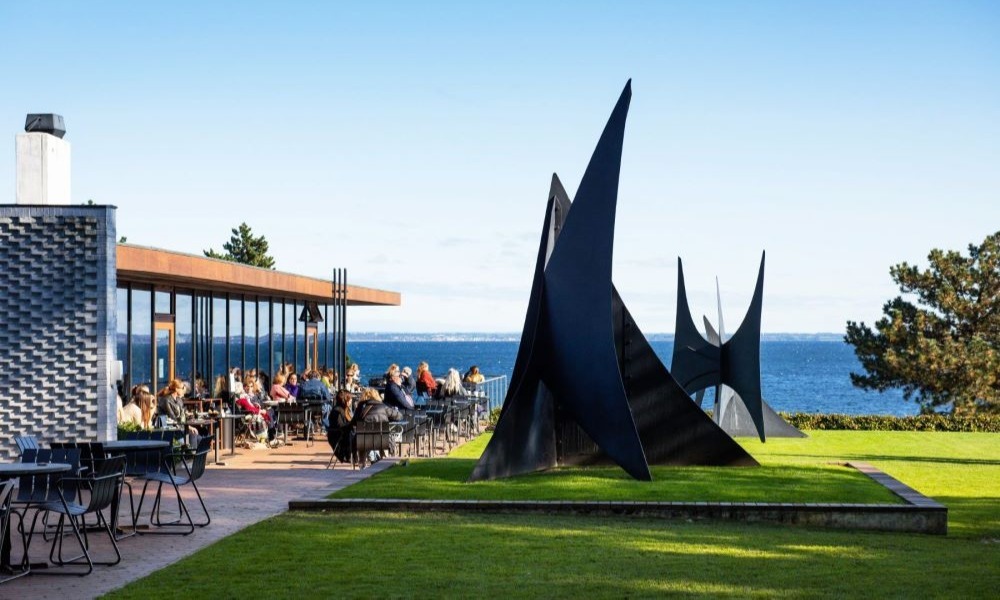I first went to Copenhagen in 1990 and returned annually en route to the Frankfurt Book Fair each October. SAS had a lovely flight, leaving at 7 in the evening and arriving at 9 the next morning. You could work all day, catch the flight and dinner and a movie, sleep and wake up in Copenhagen. I would stay a few days and then go on to Frankfurt.
Three students took me to the Louisiana Museum on my first visit. We took the train up the Baltic Coast, often called the Whiskey Coast. It is expensive land, with perfect examples of Danish modernism and older, classic Danish residential houses whose owners can afford whiskey.
The roads are gentle, the land is kept perfectly, and the train travels through the Danish National Forest. The area has the true elegance of care and style, which you can feel as you walk the road. (Walk, if you can, the four miles from Charlottenlund to Klampenborg on the Strandvejen, along the Baltic Coast; it is one of the loveliest residential roads in the world, and whichever town you end in, you are in good fortune.)
The Louisiana Art Museum is, of course, confusing to Americans; they do not easily turn their mind to the notion that the museum is in Humlebæk. It is often called the most beautiful museum in the world; to my mind, it is surely the loveliest. It is called the Louisiana as a tribute to Louise, whom I had been told was the beloved daughter of the owner of an old farmhouse on the site, but then later I read there were three Louises, his three wives.
No matter, the museum is not in Louisiana; it is up the coast from Copenhagen. Rick Sundberg, who has designed art museums and knows a thing or two, joined me one year, and as the train stopped at Humlebæk, we got out and, in true Swedish form, he looked around and said, this is the wrong stop. There is a tiny rail station, a village green, the back side of several houses, and a sleepy road. There are no signs. You can take the road, but the school kids and veterans all go off to the left, through the woods on the trail. That made Rick laugh.
You will come out of the woods at the parking lot and the Villa/Farmhouse — that is, the museum. Knud Jensen bought the villa and hired Bo and Wohlert to design the perfect modern art museum, and there it is, the gentlest, loveliest museum you shall see. It winds out to the lawn that looks out to the Baltic, and the lawn slopes down to the sea. A museum to save your heart, a landscape in which to finally sit.
Inside is a long room with a Giacometti sculpture, then a kindergarten, a restaurant that people come out to simply for dinner, and three main galleries of the purest elegance. Were Michelangelo a modernist, he would be the fall headline, just after Caravaggio.
When the Louisiana opened, the gentlest attendance was expected, but there were crowds, 200,000 people in that first year, 1958. Jensen wanted a cultural center, at the water, up the coast, a tribute to modern art — with music, food, and drink and many places to sit, and he would often scold his board of directors, “but it must be a pleasure.” We saw the Poul Kjærholm exhibit, the famous Danish modernist furniture designer, in the main gallery, and we said not a word for two hours, it was such a remarkable show.
You can walk the Strandvejen back to the station and catch the frequent train. If you have time, stop in lovely Klampenborg, the next town on the way to the city. Arne Jacobsen designed many of the buildings, including many houses and even the lifeguard tower and gas station.
There is also a brilliant museum, Ordrupgaard, a bicycle ride away, set in another mansion, with remarkable French Impressionist collections, and a very fine additional building designed by Zaha Hadid. On the edge of the museum property is another perfect example of Danish modernism, the home of another brilliant designer, Finn Juhl. All for a short bicycle ride.
It is a lot, this Danish coast. If you had stayed on the train as you started, you would have been at Elsinore, Hamlet’s famous castle, where the merchant marine tax was collected, where brooding was made famous.
Discover more from Post Alley
Subscribe to get the latest posts sent to your email.

I spent the 1972 school year abroad up the road from Louisiana at Humlebæk Folkeskole and I was able to visit often. Particularly memorable was a show of Chuck Close’s wall size superrealist paintings and a show of Jean Tinguely’s clanking kinetic art sculptural machines,
About 20 years ago, my husband and I were visiting Copenhagen, and we took a trip to Louisiana. What a gem of a museum it is! Your article brought back memories of a lovely day, the train journey to arrive there, and the delights of the museum and its exquisite surroundings.
Maybe we will return there some day.